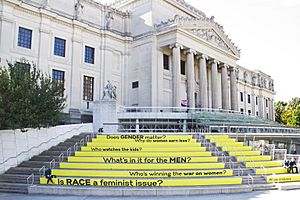Elizabeth A. Sackler Center for Feminist Art facts for kids
The Elizabeth A. Sackler Center for Feminist Art is a special part of the Brooklyn Museum in New York City. It is the first public space in the United States dedicated to feminist art. Feminist art explores ideas about equality and the experiences of women.
The Center is famous for being the permanent home of The Dinner Party, a groundbreaking art installation by Judy Chicago. The Center was founded by Elizabeth A. Sackler, a philanthropist (a person who gives money to good causes) and art lover.
Contents
History of the Center
The Elizabeth A. Sackler Center for Feminist Art opened on March 23, 2007. Its goal is to teach people about feminism and show how it has shaped art and culture. The center is a large space, covering about 8,300 square feet, on the museum's fourth floor.
From the day it opened, the Center has displayed Judy Chicago's famous artwork, The Dinner Party. The Center also has a space called The Forum, where people can gather for talks and events about women's issues.
What the Center Looks Like
The main attraction of the Center is the gallery for The Dinner Party. This space was designed by architect Susan T. Rodriguez. The artwork itself is a huge triangular table with 39 unique place settings, each one honoring an important woman from history.
The floor beneath the table, called the Heritage Floor, features the names of 998 other important women. The entire installation is enclosed by large glass walls, so visitors can see it as they approach. Around this main gallery, there are other spaces for changing art exhibits and a study center.
Special Exhibitions
The Center hosts many different art shows. The very first exhibition was called "Global Feminisms," which showed feminist art made by artists from all over the world between 1990 and 2007.
Some other past exhibitions include:
- "Georgia O'Keeffe: Living Modern" (2017)
- "We Wanted a Revolution: Black Radical Women, 1965–85" (2017)
- "Radical Women: Latin American Art, 1960–1985" (2018)
- "Roots of 'The Dinner Party': History in the Making" (2017-2018)
- "'Workt by Hand': Hidden Labor and Historical Quilts" (2013)
The Feminist Art Base
A cool project at the Center is the Feminist Art Base. It's an online database, like a digital library, full of artists whose work is connected to feminist ideas.
Artists from around the world can add their own profiles to the database. Each profile includes information about the artist, their work, and a statement explaining what feminist art means to them. This helps create a growing record of feminist artists and their contributions.
The Sackler Center First Awards
To celebrate its fifth anniversary in 2012, the Center started the Sackler Center First Awards. These awards are given to women who were the "first" in their field to achieve something amazing. The awards honor women who have broken down barriers and made a big impact on society.
Notable Honorees
Over the years, many inspiring women have received this award. Here are a few of them:
- 2012: Toni Morrison, a Nobel Prize-winning author.
- 2012: Sandra Day O'Connor, the first woman to serve as a Justice on the U.S. Supreme Court.
- 2013: Julie Taymor, the first woman to win a Tony Award for directing a musical.
- 2014: Anita Hill, a lawyer and professor known for her advocacy.
- 2015: Miss Piggy, the famous Muppet character, honored for being a role model of spirit and determination.
- 2016: Angela Davis, a well-known activist and writer.
See also
 In Spanish: Centro de arte feminista Elizabeth A. Sackler para niños
In Spanish: Centro de arte feminista Elizabeth A. Sackler para niños


